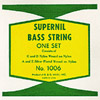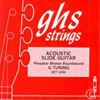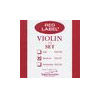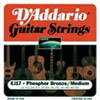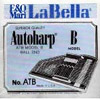Free Shipping $149 or More! Enter FS149 on Checkout - Excludes Bass Fiddles
Domestic Shipping Only
803-467-5233
Digital Downloads
 |
||
StringsEvery acoustic instruments need strings to actually provide the tone of the instrument. Regardless the quality of woods, the careful craftsmanship and attention to detail, the most expensive instruments can't make a tone without the string, which is a relatively inexpensive item. The string is the element that provides the source of vibration on bluegrass instruments like the guitar, banjo, fiddle, mandolin, dobro and bass. Strings come in a huge variety of materials and gauges for differing tonal qualities and notes. |
||
Banjo Strings
The banjo string provides the vibration, which transfers through the floating bridge, to the head of the banjo, which creates to tone. Typically, banjo strings have a loop end to attach to the tailpiece. Most common material is nickel, and the first through third and fifth string are unwound and the fourth string is wound. There are various gauges of string sets to accommodate the players style and the tonal qualities of each individual banjo.
Bass Strings
Bass strings are a very heavy gauge (Thickness) necessary to produce the long wavelengths and low tones of the bass instrument. Traditionally, bass violin strings were made of gut for an even mellow tone. While gut strings are still available, the cost and high maintenance has seen them be replaced by synthetic materials. Steel strings as well as a synthetic material wrapped with steel are also a common bass string construction.
Dobro Strings
Dobro strings provide vibration through the bridge and to the cone and soundwell. Dobro strings typically have a ball end to slip into the slot in the bridge. Dobro strings come in many different gauges (thicknesses) and materials. Flat and semi-flat wound strings are a popular option to reduce bar noise. We carry the best brands of dobro strings and several signature series sets by artists such as Tim Shearhorn and Phil Ledbetter.
Fiddle Strings
Fiddle strings were originally made of sheep's intestine, also called catgut. Most fiddle strings today are either a stranded synthetic core wound with metal, or a solid or stranded steel core, wound with metals. Fiddle strings may have several layers of winding to influence the warmth or brightness of the string. Fiddle string prices vary greatly by the materal type with gut-core being the most expensive, followed by synthetic cores, and the cheapest being steel cores.
Guitar Strings
Guitar strings provide the vibration that travels through the bridge and saddle to vibrate the top of an acoustic guitar, with the sound further vibrating inside the chamber and exiting the soundhole. Today, there are as many different types and gauges of strings as there are varying tastes in music. A heavier gauge guitar string (higher number) provides higher tension and generally a louder tone, Lighter strings provide a softer tone and are easier on the fingers.
Mandolin Strings
Mandolin strings come in sets of eight, with two of each gauge that are strung in pairs. The strings provide the vibration for the instrument which transfers through the bridge, and causes the top of the mandolin to vibrate and produce a tine. Mandolin strings typically have loop ends to attach to the tailpiece. Usually, the first two pair of strings are plain, with the lower two being wound. Mandolin sets come in various materials and gauges to suit any players taste.
Other Strings
Autoharp strings and dulcimer strings at PlayBetterBluegrass.com. All autoharp and dulcimer strings are discount priced and most ship the same day.
| Items [25] |  |



 " width="185" height="205"/>
" width="185" height="205"/>



